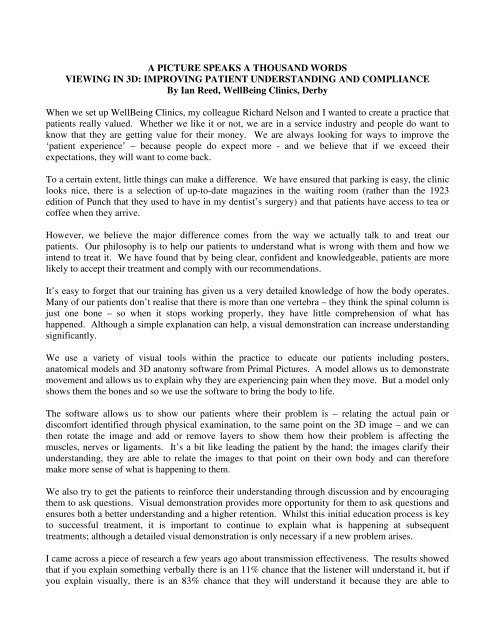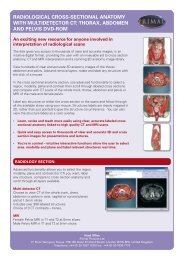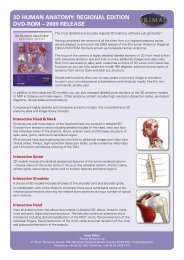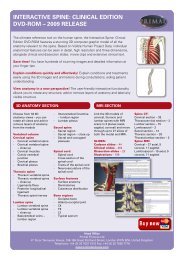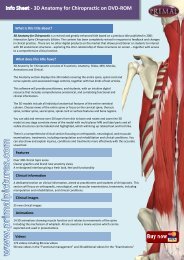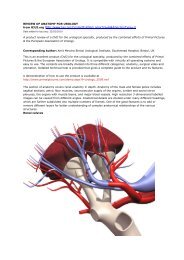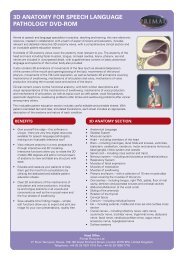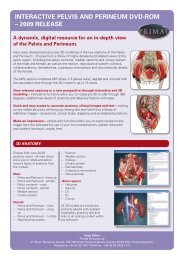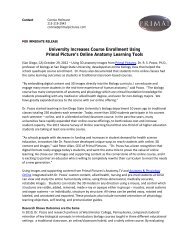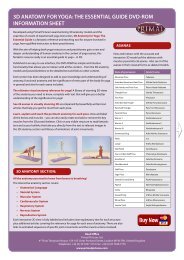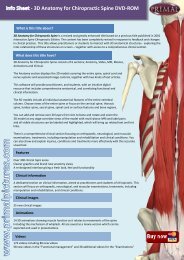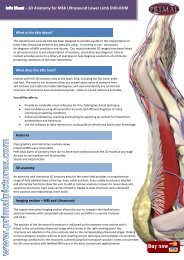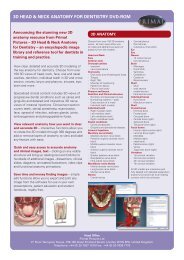Download Ian Reed's case study as a pdf - Primal Pictures
Download Ian Reed's case study as a pdf - Primal Pictures
Download Ian Reed's case study as a pdf - Primal Pictures
You also want an ePaper? Increase the reach of your titles
YUMPU automatically turns print PDFs into web optimized ePapers that Google loves.
A PICTURE SPEAKS A THOUSAND WORDS<br />
VIEWING IN 3D: IMPROVING PATIENT UNDERSTANDING AND COMPLIANCE<br />
By <strong>Ian</strong> Reed, WellBeing Clinics, Derby<br />
When we set up WellBeing Clinics, my colleague Richard Nelson and I wanted to create a practice that<br />
patients really valued. Whether we like it or not, we are in a service industry and people do want to<br />
know that they are getting value for their money. We are always looking for ways to improve the<br />
‘patient experience’ – because people do expect more - and we believe that if we exceed their<br />
expectations, they will want to come back.<br />
To a certain extent, little things can make a difference. We have ensured that parking is e<strong>as</strong>y, the clinic<br />
looks nice, there is a selection of up-to-date magazines in the waiting room (rather than the 1923<br />
edition of Punch that they used to have in my dentist’s surgery) and that patients have access to tea or<br />
coffee when they arrive.<br />
However, we believe the major difference comes from the way we actually talk to and treat our<br />
patients. Our philosophy is to help our patients to understand what is wrong with them and how we<br />
intend to treat it. We have found that by being clear, confident and knowledgeable, patients are more<br />
likely to accept their treatment and comply with our recommendations.<br />
It’s e<strong>as</strong>y to forget that our training h<strong>as</strong> given us a very detailed knowledge of how the body operates.<br />
Many of our patients don’t realise that there is more than one vertebra – they think the spinal column is<br />
just one bone – so when it stops working properly, they have little comprehension of what h<strong>as</strong><br />
happened. Although a simple explanation can help, a visual demonstration can incre<strong>as</strong>e understanding<br />
significantly.<br />
We use a variety of visual tools within the practice to educate our patients including posters,<br />
anatomical models and 3D anatomy software from <strong>Primal</strong> <strong>Pictures</strong>. A model allows us to demonstrate<br />
movement and allows us to explain why they are experiencing pain when they move. But a model only<br />
shows them the bones and so we use the software to bring the body to life.<br />
The software allows us to show our patients where their problem is – relating the actual pain or<br />
discomfort identified through physical examination, to the same point on the 3D image – and we can<br />
then rotate the image and add or remove layers to show them how their problem is affecting the<br />
muscles, nerves or ligaments. It’s a bit like leading the patient by the hand; the images clarify their<br />
understanding, they are able to relate the images to that point on their own body and can therefore<br />
make more sense of what is happening to them.<br />
We also try to get the patients to reinforce their understanding through discussion and by encouraging<br />
them to <strong>as</strong>k questions. Visual demonstration provides more opportunity for them to <strong>as</strong>k questions and<br />
ensures both a better understanding and a higher retention. Whilst this initial education process is key<br />
to successful treatment, it is important to continue to explain what is happening at subsequent<br />
treatments; although a detailed visual demonstration is only necessary if a new problem arises.<br />
I came across a piece of research a few years ago about transmission effectiveness. The results showed<br />
that if you explain something verbally there is an 11% chance that the listener will understand it, but if<br />
you explain visually, there is an 83% chance that they will understand it because they are able to
picture it. Combining a verbal and a visual explanation therefore gives you a 94% chance of getting<br />
your message across effectively.<br />
The saying goes that a picture speaks a thousand words and visual explanation really does improve<br />
understanding enormously. This ability to educate our patients with a powerful visual tool is<br />
invaluable. It’s a major factor in improving our service to our patients and h<strong>as</strong> a tremendous affect on<br />
patient compliance and satisfaction.<br />
About <strong>Ian</strong> Reed<br />
<strong>Ian</strong> Reed trained at AECC and qualified in 1992. He set up WellBeing Clinics in Derby with his<br />
colleague, Richard Nelson in March 2000. For more information on WellBeing Clinics, ple<strong>as</strong>e<br />
visit www.wellbeingclinics.co.uk.


